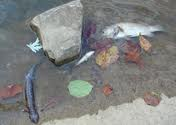Restoration plans were described on August 25th in Morgantown for Dunkard Creek. In September of 2009, some 22,000 fish and thousands of mussels (14 species) were decimated by the toxins from an extensive golden algae bloom. The algae may well have invaded from Texas or Oklahoma where it is rather common, in brackish waters. The algae bloom was possible because of the high level of total dissolved solids resulting from mining operations, over 20,000 parts per million (or milligrams per liter).
CONSOL has now broken ground on a $200 million water treatment facility near Mannington (Marion county) to remove dissolved inorganic compounds (salts) from about 2500 gallons per minute of contaminated mine water from three area mines, namely Blacksville 2 (Monongalia county), Loveridge (Marion county), and Robinson Run (Harrison county). The treated product water will go to the Hibbs Reservior, which drains into Buffalo Creek. The residue filter cake and crystallized salts will be landfilled near the treatment plant.
The WV Division of Natural Resources (DNR) described a five year project to restore smallmouth bass and 30 inch muskies to Dunkard Creek. Another project was described to restore six mussel species if possible, described as difficult and complex. Mussels depend upon adequate water flow and a fish population as well as limits on contaminants. Seasonal variations in flow rate and water removals for mining operations and Marcellus hydrofracking could be a serious challenge for the mussel restoration plan. Northeast Natural Energy already has Marcellus drilling operations ongoing near Dunkard Creek.
David Wellman of WV-DNR reported that earlier instances of golden algae detection in other streams of West Virginia were probably in error, and that even Dunkard Creek has not shown the presence of the golden algae since November of 2009. Apparently, golden algae are very difficult to detect and easily misidentified. Residual golden algae may well remain in Dunkard Creek. And, the theory still remains that the occurrence of the golden algae in Dunkard Creek arose from contaminated trucks working here in the Marcellus gas industry, from Texas or Oklahoma.
Information on the 2009 Dunkard Creek Fish Kill is available from the WV-Department of Environmental Protection. Shortly, the WV-DNR is to post their “Proposed Dunkard Creek Fish and Mussel Restoration Plan” on the following web-site and provide for a thirty day comment period: Select the “Fishing” category at www.wvdnr.gov


{ 1 comment… read it below or add one }
PRESENTATIONS FROM AUGUST MEETING OF WATERSHEDS COMPACT NOW POSTED
The presentations from the August Compact Public Meeting on Dunkard Creek Restoration are posted now on the UMRA web site:
http://www.uppermon.org/Mon_Watershed_Group/PowerPoints-etc/Meeting_10-Aug11/index.html
Note that these are mostly very large files, and will be slow to download, even though they have been converted to .PDF format.